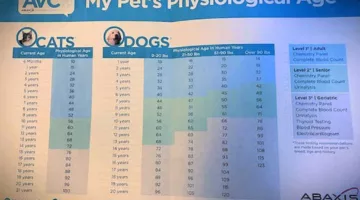
You’ve heard for years that to figure a dog’s age in “dog years” you should just add 7 to each year that your dog has been alive. That should give you the human equivalent of your dog’s age, right?
Wrong!
Use the chart below to accurately determine the age of your dog — dog years compared to human years.
Dog Age vs. Human Age: Physical/Physiological Age
This chart reflects the most accurate dog ages, compared to human ages:
| Dog Age | Human Age |
|---|---|
| 6 months | 10 years |
| 8 months | 13 years |
| 10 months | 14 years |
| 12 months | 15 years |
| 18 months | 20 years |
| 2 years | 24 years |
| 4 years | 32 years |
| 6 years | 40 years |
| 8 years | 48 years |
| 10 years | 56 years |
| 12 years | 64 years |
| 14 years | 72 years |
| 16 years | 80 years |
| 18 years | 88 years |
| 20 years | 96 years |
| 21 years | 100 years |

The above figures are based on “averages” and they hold true for most dogs — generally speaking.
However, there’s a new dog age calculator that also takes into consideration the dog’s breed! Because size and genetics matter when determining how a dog ages and how long they are likely to live.
So, this chart combines your dog’s chronological age and your dog’s size/weight to determine your dog’s physiological age.
A dog’s physiological age takes into account all of the mechanisms that work to keep the body alive and functioning. Your dog’s physiological age is a combination of their internal health and physical abilities — based on age, size, and weight.
The easiest equation (7:1) is probably the least accurate. Formulas that take into consideration the faster development that occurs the first 2 years of life give a more accurate comparison. But even with this theory, there is variation. Some mathematicians feel that a 1-year-old dog should be compared to a 10- to 15-year-old human. The second year, as development levels out, should equate to 3 to 8 years of human aging. That would put a 2-year-old dog on par with a 13- to 23-year-old human. But that’s still a big range. In short, there is no definitive answer to the math problem. There is just too much variability in the canine community. Too many breeds. Too many sizes. What is consistent is the fact that dogs age more rapidly than their owners do. What is consistent is the fact that a 1-year-old dog often resembles a gangly teenager. What is consistent is that a 4-year-old dog has the energy of a young adult. What is consistent is that a 9-year-old dog walks with the stiff gait of a senior citizen.
~ VCA Hospitals
So that’s how you determine the physical age of your dog — based on how many years your dog has been alive, in comparison with the human lifespan.
Now, what about your dog’s mental age?
Dog Age vs. Human Age: Mental/Behavioral Age
Here, it becomes more about “maturity” than about a dog’s mental abilities or actual intelligence.
Because when you look at intelligence alone, it has been said (unfortunately) that a dog’s intelligence level is on par with a 2-year-old human. That, of course, is speaking very generally — and applies to dogs of all ages. I mean, my dog seems WAY smarter than a 2-year-old! And I bet yours does, too.
But the fact is all dogs have the ability to learn and grow and thrive better (or worse) than other dogs of the same age.
Perhaps this is where the traditional 7:1 age ratio for dogs vs. humans rings the most true — on the behavioral / emotional level.
So, for example a 10-year-old dog is considered to be emotionally equivalent (or “acts like”) a 70-year-old human, while a 12-year-old dog is very similar to (or “acts like”) an 84-year-old human… and so on.
Emotional maturity doesn’t align with physical maturity. Emotional maturity occurs over an extended period of time. For example, a 21-year-old human is considered an adult, but may not reach emotional maturity until age 40 or so. The same applies to dogs. Even though a 9-month-old pup may be socially and sexually active, full maturity isn’t achieved until age 3 or 4. That’s why 2-year-old Labradors still chew your favorite slippers!
~ VCA Hospitals
Want to see how smart your dog is?
More About Dog Age & Birthdays
Like this post? Save it to read again later… or share with others on Pinterest!





